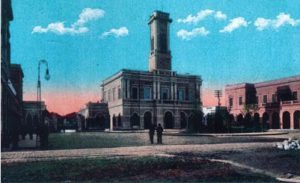There was the city, three million souls within the legal boundaries, and many more within the real boundaries, as defined by geography, work, and political loyalties. And there was the slaughterhouse, the only one legally designated to serve the city, as defined by political patronage, nationalistic economics and culture.
The slaughterhouse was a city within the city, a sprawling complex of buildings covering the equivalent of several city blocks, located, not by chance, in the blue-collar neighborhood of Mataderos, which bored that name since colonial times, not by design, but by history, as the numerous and much smaller predecessor slaughterhouses (mataderos) were located there.
Mataderos was a rough neighborhood, perhaps made tougher by the occupation of its inhabitants, people who worked with a knife in their hands, a fact that married perfectly with a tradition of knife duels, brought into the city by the gauchos and peasants when they left behind their horse, their vast, treeless, unbound plains, and their freedom.
The several thousand workers of the slaughterhouse received medical attention at their own ER, which was indeed a small, fully staffed hospital, able to do much more than taking care of superficial wounds, serving both the workers and the neighbors, as provided by a political system that took a comprehensive approach to places of work.
There was probably no better way to get to know the Mataderos neighborhood than through the stories that ambled like ghosts through the corridors of its hospital. These were stories of courage, honor, betrayal, and fate, very much like the tango, which reigned supreme, a parting gift from the blacks before vanishing in history, taking all the joy with them, and leaving all the pain. Argentines are said to be an inward looking, nostalgic people.
As said, knife duels were not uncommon and deadly, the method of choice for serious disputes, eclipsing handguns, which were deemed as inappropriate for matters of honor, and fist fights, which were adequate only for the underage, or for disagreements over boxing or soccer. It was the middle of the twentieth century, but the nineteenth century lived on.
In the Mataderos ER worked a young doctor. Besides workers and occasional laborers, his patients included policemen, small-time politicians and petty criminals. Many liked to talk, and he liked to listen.
It was the case of a pre-announced crime. Someone felt disrespected, and was going around talking of settling the score. The supposed offender got wind of the threat, and was prepared, just in case it materialized. The police chief also heard of the situation, and decided that early intervention was called for.
The officer summoned the potential challenger to his office, and they had a very private conversation. Weeks, months, years passed and there was never a confrontation between the two men involved in the dispute. Nobody ever learned how the conflict was resolved, or whatever happened. However, one person had privileged information.
In the privacy and trust of a doctor’s office, the police chief told the young doctor of his opportune and forceful intervention in the course of the dispute. In the brief meeting he had with the offended party, he said something like this:
“I am very concerned that someone has made threats against this man. I want you to do me a personal favor: look after him, and make sure he is completely safe. I know I can count on you. If anything happens to him, I will be very disappointed in you.”
In an imperfect world, both honor and life were thus preserved.

